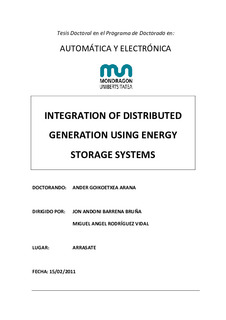
Ikusi/
Izenburua
Integration of distributed generation using energy storage systemsEgilea
Irakurtze Data
2011-05-05Argitalpen data
2011Dokumentu-mota
Doktore tesiaDoktore tesiaHizkuntza
IngelesaEskubideak
© Ander Goikoetxea AranaSarbidea
Sarbide irekiaArgitaratzailearen bertsioa
https://doi.org/10.48764/5gqf-zg90Argitaratzailea
Mondragon Unibertsitatea. Goi Eskola PoliteknikoaGako-hitzak
Transmisión y distribución eléctricaDistribución de energia
fuentes no convencionales de energía
Laburpena
New challenges in grid reliability are coming up with the increasing penetration of renewable energies and distributed generation (DG). The use of Energy Storage Systems (ESS) is proposed in this thes ... [+]
New challenges in grid reliability are coming up with the increasing penetration of renewable energies and distributed generation (DG). The use of Energy Storage Systems (ESS) is proposed in this thesis as solution for different problems related to these new challenges.
The development and current state of ESS are described in this thesis. This description permits to choose the best solution for the different scenarios that are analyzed.
The analysis of electrical grids is carried out by means of simulation tools. For this purpose a dynamic power calculation is proposed. The modeling of electrical components and their implementation in the proposed simulation tool permits to analyze the frequency and voltage stability of power systems. These two are the most important parameters for grid operation and therefore the most important parameters to analyze the integration of DG.
Some applications related to the use of ESS as a solution for a certain problem related to the high penetration of DG are analyzed in the present work. Voltage regulation, restoration of large frequency deviations, primary frequency regulation and the control of the power dispatch of a wind farm are proposed as applications for ESS.
The design of an application combining these functionalities is discussed. Hybrid ESS that combines different ESS technologies is proposed as a single solution for all the applications analyzed during the course of this thesis. [-]
Energia berriztagarrien eta Sorkuntza Barreiatuaren (SB) erabilera azkorrak erronkau berriak aurkezten ditu sare elektrikoen sinesgarritasunari begira. Tesi honetan Energia Metatzeko Sistemen (EMS) er ... [+]
Energia berriztagarrien eta Sorkuntza Barreiatuaren (SB) erabilera azkorrak erronkau berriak aurkezten ditu sare elektrikoen sinesgarritasunari begira. Tesi honetan Energia Metatzeko Sistemen (EMS) erabilera eztabaidatzen da aipatutako erronketatik eratorritako zenbait arazo konpontzeari begira.
EMSen garapena eta egungo egoera azaltzen dira tesi honetan. Deskribapen honek tesi honetan aztertzen diren egoera desberdinentzat konponbide egokiena hautatzea ahalbideratzen du.
Sare elektrikoen azterketa simulaziorako tresnen bidez egiten da. Helburu hau betetzeko potentzia fluxuen kalkulu dinamikoa proposatzen da. Osagai elektrikoen modelatzeak eta beren inplementazioak proposaturiko simulazio tresnan potentziako sistemen tentsio eta frekuentziaren azterketa egitea ahalbideratzen du. Bi parametro hauek dira garrantzitsuenak sare elektrikoaren operazioaren ikuspegitik eta honenbestez parametro garrantzitsuenak dira SBren integrazioa aztertzeko orduan.
Lan honetan EMSen erabileraren inguruko hainbat aplikazio aztertzen dira, SBren sarrera handiarekin erlazionatutako zenbait arazori konponbidea bilatzeko. Tentsioaren erregulazioa, frekuentziaren desbideratze handien berreskurapena, frekuentziaren erregulazio primarioa eta parke eolikoen despatxu kontrolatua EMSentzako aplikazio bezala proposatzen dira.
Funtzio guzti hauek beteko lituzken aplikazio baten diseinua eztabaidatzen da. EMS Hibrido bat proposatzen da EMS teknologia desberdinak konbinatuko dituena, lan honetan aztertu diren aplikazio desberdinentzako soluzio bezala. [-]
La creciente penetración de energías renovables y Generación Distribuida (GD) presentan nuevos retos en la fiabilidad de las redes eléctricas. El uso de Sistemas de Almacenamiento de Energía (SAE) se ... [+]
La creciente penetración de energías renovables y Generación Distribuida (GD) presentan nuevos retos en la fiabilidad de las redes eléctricas. El uso de Sistemas de Almacenamiento de Energía (SAE) se propone en esta tesis como solución a diferentes problemas derivados de los mencionados retos.
El desarrollo y el actual estado de los SAE se describen en esta tesis. Esta descripción permite elegir la mejor solución ante los diferentes escenarios que se analizan.
El análisis de las redes eléctricas se realiza mediante herramientas de simulación. Con este objetivo se propone el cálculo dinámico de los flujos de carga. El modelado de componentes eléctricos y su implementación en la herramienta de simulación propuesta permite analizar la estabilidad del voltaje y la frecuencia en los sistemas de potencia.
Estos dos parámetros son los más importantes para operación de la red eléctrica y por consiguiente son los parámetros más importantes para analizar la integración de la GD.
En este trabajo se analizan varias aplicaciones relacionadas con el uso de los SAE como solución a ciertos problemas relacionados con la alta penetración de la GD. Regulación de voltaje, restitución de grandes desviaciones de frecuencia, regulación primaria de frecuencia y el despacho controlado de los parques eólicos se proponen como aplicaciones para SAE.
Se debate el diseño de una aplicación que combine estas funcionalidades. Se propone un SAE Híbrido que combine diferentes tecnologías de SAE como solución única para todas las aplicaciones analizadas durante el curso de esta tesis. [-]
Bildumak
- Tesiak - Ingeniaritza [243]
Item honek honako baimen-fitxategi hauek dauzka asoziatuta:




















